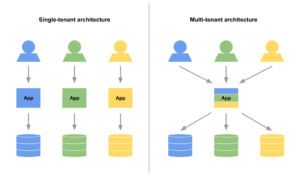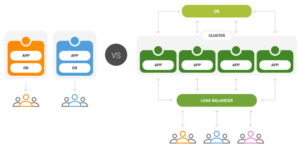Multi-tenancy has emerged as a pivotal concept, particularly in the context of school IT systems. Multi-tenancy refers to a software architecture where a single instance of an application serves multiple customers, or “tenants.”
Each tenant’s data is isolated and invisible to others, but the application is designed to handle numerous tenants concurrently.
This model offers significant advantages in terms of cost-efficiency, scalability, and maintenance.
However, it also presents a unique set of challenges that need to be addressed to ensure robust and secure operations.
Understanding Multi-Tenancy
Definition and Mechanism
Multi-tenancy is a crucial design paradigm in cloud computing and software as a service (SaaS) environments.
 In a multi-tenant architecture, multiple users (tenants) share the same application instance and underlying database while maintaining their data’s logical separation.
In a multi-tenant architecture, multiple users (tenants) share the same application instance and underlying database while maintaining their data’s logical separation.
This is achieved through metadata tables that store information about each tenant, such as user configurations and data mappings.
The system dynamically adjusts to serve each tenant’s data requests, ensuring data integrity and privacy.
Imagine a large apartment building. This building has many apartments, and each apartment is rented out to different families. While all families share the same building structure, each family has its own apartment with separate rooms, kitchens, and bathrooms. The families don't mix their personal spaces, even though they live in the same building. Multi-tenancy in IT systems is similar to this apartment building. It means that one software application serves multiple groups of users (tenants), but each group has its own separate space within the application. They share the same overall system, but their data and activities are kept separate and private.
Importance of Multi-Tenancy in School IT Systems
The importance of multi-tenancy in school IT systems can be understood through several key points:
- Cost Efficiency: Multi-tenancy reduces costs by allowing multiple schools or educational institutions to share the same infrastructure and application resources. This shared model lowers the overall expenditure on hardware, software licenses, and maintenance.
- Scalability: Multi-tenant systems can easily scale to accommodate a growing number of users and data volumes. This scalability is crucial for educational institutions that may experience fluctuating student populations and varying demands for IT resources.
- Centralized Management: IT administrators can manage updates, security patches, and configurations centrally, ensuring consistent performance and security across all tenants. This centralized approach simplifies the administration and maintenance of IT systems.
- Customization: Multi-tenant architectures support customization at the tenant level, allowing schools to tailor the system to their specific needs without affecting other tenants. This flexibility enhances user experience and functionality.
Challenges of Implementing Multi-Tenancy in School IT Systems
While multi-tenancy offers numerous benefits, it also introduces several challenges that must be carefully managed to ensure effective implementation and operation.
Data Security and Privacy
One of the primary concerns in a multi-tenant environment is ensuring the security and privacy of each tenant’s data.
Educational institutions handle sensitive information, including student records, staff details, and academic performance data. The risks associated with data breaches, unauthorized access, and data leakage are significant.
To address these concerns, robust encryption methods must be employed both in transit and at rest. Additionally, strict access controls and regular security audits are essential to maintaining data integrity and compliance with regulations such as the Family Educational Rights and Privacy Act (FERPA) and the General Data Protection Regulation (GDPR).
Performance Isolation
Another challenge is ensuring that the performance of one tenant does not adversely affect others.
In a multi-tenant system, resource contention can occur, leading to performance degradation.
For instance, if one school experiences a sudden surge in activity, it could impact the overall system's responsiveness, affecting other schools sharing the same infrastructure.
 Implementing resource allocation strategies, such as workload balancing and dynamic scaling, can mitigate these issues. Additionally, monitoring tools can help identify and address performance bottlenecks proactively.
Implementing resource allocation strategies, such as workload balancing and dynamic scaling, can mitigate these issues. Additionally, monitoring tools can help identify and address performance bottlenecks proactively.
Customization and Interoperability
While multi-tenancy supports customization, ensuring these customizations do not interfere with the core system or other tenants’ operations is challenging.
Schools may have unique requirements, necessitating bespoke configurations and integrations with other systems.
A modular design approach, where core functionalities are separated from tenant-specific customizations, can help manage these complexities.
Furthermore, adherence to interoperability standards ensures that the system can seamlessly integrate with other educational technologies and platforms.
Compliance and Governance
Educational institutions must comply with various regulatory requirements related to data protection, accessibility, and operational transparency.
Multi-tenant systems need to provide comprehensive compliance features, such as audit logs, data retention policies, and access controls, to meet these standards.
Establishing a governance framework that outlines roles, responsibilities, and procedures for managing compliance across all tenants is critical. This framework ensures that all regulatory obligations are consistently met, reducing the risk of non-compliance.
Solutions to Overcome Multi-Tenancy Challenges
Advanced Security Measures
To address data security and privacy challenges, multi-tenant systems should implement advanced security measures, including:
- Encryption: Use strong encryption algorithms for data at rest and in transit to protect sensitive information.
- Access Controls: Implement role-based access control (RBAC) and multi-factor authentication (MFA) to ensure only authorized personnel can access critical data.
- Regular Audits: Conduct regular security audits and vulnerability assessments to identify and mitigate potential risks.
Resource Management and Performance Optimization
Effective resource management and performance optimization strategies are essential to ensure performance isolation and system reliability:
- Resource Allocation: Use containerization and virtualization technologies to allocate resources dynamically based on tenant demands.
- Load Balancing: Implement load balancing techniques to distribute workloads evenly across servers, preventing any single tenant from monopolizing resources.
- Monitoring and Alerts: Deploy monitoring tools to track system performance in real time and set up alerts for unusual activity or potential issues.
Modular Architecture and Customization Frameworks
A modular architecture and robust customization frameworks can address the challenges of customization and interoperability:
- Microservices Architecture: Adopt a microservices architecture that separates core functionalities from tenant-specific customizations, enabling independent updates and maintenance.
- APIs and Integration: Develop comprehensive APIs that allow seamless integration with other educational technologies and platforms, facilitating interoperability.
- Customization Tools: Provide tenants with user-friendly customization tools that enable them to tailor the system to their needs without requiring extensive technical knowledge.
Compliance and Governance Frameworks
Establishing a robust compliance and governance framework is crucial for meeting regulatory requirements:
- Audit Logs: Maintain detailed audit logs of all system activities to provide transparency and traceability.
- Data Retention Policies: Implement data retention policies that comply with regulatory requirements and ensure timely deletion of outdated data.
- Governance Committees: Form governance committees that include representatives from each tenant to oversee compliance and address any issues collaboratively.
Market Trends
Market studies indicate a growing adoption of multi-tenant systems in the education sector.
According to a report by MarketsandMarkets, the global education technology market is projected to reach USD 232.9 billion by 2027, with a significant portion attributed to cloud-based solutions and multi-tenant architectures.
The report highlights that multi-tenancy’s scalability and cost-efficiency are key drivers of this growth.
Conclusion
Multi-tenancy in school IT systems offers numerous benefits, including cost efficiency, scalability, centralized management, and customization.
However, it also presents challenges related to data security, performance isolation, customization, and compliance.
By implementing advanced security measures, effective resource management strategies, modular architectures, and robust compliance frameworks, educational institutions can overcome these challenges and fully realize the potential of multi-tenant systems.
As the education technology market continues to grow, multi-tenancy will play an increasingly important role in shaping the future of school IT systems.
By embracing this architecture, schools can enhance their operational efficiency, improve data security, and provide a more personalized and seamless experience for students and staff.
Cybersecurity professionals in the education sector must stay informed about the latest trends and best practices in multi-tenancy to ensure their systems are secure, compliant, and capable of meeting the evolving needs of modern educational environments.








